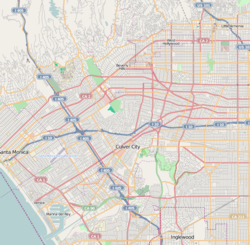world.wikisort.org - USA
South Carthay is a neighborhood in Central Los Angeles, California. Located south of Carthay Circle,[1] South Carthay was developed in the 1930s by Spyros George Ponty.
South Carthay, Los Angeles | |
|---|---|
Neighborhood of Los Angeles | |
 South Carthay signage located at 1025 S. Crescent Heights Boulevard (just south of Olympic Boulevard) | |
 South Carthay, Los Angeles Location within Los Angeles | |
| Coordinates: 34°03′41″N 118°22′11″W | |
| Country | |
| State | |
| County | |
| Time zone | Pacific |
| Zip Code | 90048 |
| Area code(s) | 323 |
Geography
The neighborhood is bounded by Olympic Boulevard on the north, La Cienega Boulevard on the west, Pico Boulevard on the south, and Crescent Heights Boulevard on the east.[2]
History
The South Carthay area became a portion of the City of Los Angeles on February 28, 1922.[3] Residential development in the area began during the early 1930s on land that previously grew produce for Ralphs markets.[4] Greek developer Spyros George Ponty worked with architect Alan Ruoff[5] to design 147 modest Mediterranean-style homes in the area.[6] While the builder's influence is found in Westwood, Norwalk, Beverly Hills, South-Central Los Angeles and the San Fernando Valley, South Carthay's Spanish Colonial Revival homes represents one of his earliest legacies.[7] All of the 147 homes designed by Ponty share red-tiled roofs and stucco exterior walls, wrought iron and glazed-tile detailing. Yet each home was built slightly differently from the next, with flipped floor plans and doors and windows in different places.[7] South Carthay remains an architecturally cohesive community, with few intrusions from the succeeding decades.[2]
Historic Preservation Overlay Zone
In 1984, South Carthay became the second neighborhood in the city to receive the designation of Historic Preservation Overlay Zone (HPOZ).[7] The South Carthay preservation plan was adopted by the City of Los Angeles on December 9, 2010. Objectives of the HPOZ include: Safeguarding the character of historic buildings and sites and recognizing and protecting the historic streetscape and development patterns.[8] The HPOZ boundaries exclude the commercial thoroughfares of Pico Boulevard and La Cienega Boulevard.[9]
References
- The Thomas Guide, 2008, page 633
- Winkler, Robert (September 2009). An Arch Guidebook to Los Angeles. p. 163. ISBN 9781423608936.
- "Los Angeles City Office of Historic Resources" (PDF). p. 17.
- Stein, Jeannine. "The Quest for a Sense of Place". Los Angeles Times.
- "The History of South Carthay". South Carthay Neighborhood Association.
- Heeger, Susan. "STYLE / Garden : REAL GREEN ROOMS". Los Angeles Times.
- Mothner, Linda Beth. "City With Sense of History and Direction : South Carthay".
- "Los Angeles City Office of Historic Resources" (PDF). p. 5.
- "Los Angeles City Office of Historic Resources" (PDF). p. 22.
Другой контент может иметь иную лицензию. Перед использованием материалов сайта WikiSort.org внимательно изучите правила лицензирования конкретных элементов наполнения сайта.
WikiSort.org - проект по пересортировке и дополнению контента Википедии
